IDEX Online Research: Inflation Hits Jewelry Industry in September
October 29, 12
(IDEX Online) – Jewelry prices in the American market surged in September, at both the retail and supplier levels, primarily as a result of sharply higher commodity prices for precious metals.
During September, gold prices rose by over 7 percent from August, while silver and platinum posted double-digit increases in September versus August. Diamonds were about the only major jewelry commodity that did not post an increase in price during September, a trend that has continued into October.
What’s behind precious metal price inflation? Global economic worries continue to push investors to seek “hard” assets such as gold, rather than “paper” assets such as stocks and bonds. After languishing during the summer, precious metals prices began rising late in the third quarter, and have continue to move higher in the fourth quarter. Despite attempts by the industry to try to “monetize” diamonds as a hard asset, investors remain skeptical and have not focused on these gemstones as a “store of value.”
The Big Picture: Will Higher Jewelry Prices Scare Off Shoppers?
Earlier this year, retail jewelers were hesitant to raise their retail prices, since jewelry demand was relatively weak.
Though retail jewelry sales remain relatively weak, jewelers have had to raise prices in the face of higher supplier prices for jewelry that contains gold, silver and platinum. Retail merchants are betting that jewelry demand will not be affected significantly; further, they need to move prices higher prior to the holiday selling season.
In some cases, they have raised prices so they can discount them during the holiday selling season, without breaking any commerce laws (which say that an item must have been offered for a minimum period at the higher price, if the discount is legitimate).
However, it is important to note that the consumer environment of high levels of uncertainty is unchanged. The current climate of uncertainty is being driven by the upcoming presidential election, a faltering economy, the lack of job security, and a weak housing market. When consumers are uncertain, they tighten their purse strings.
WHOLESALE: Jewelry Prices Jump in September
In September, the Jewelry Producer Price Index (JPPI) stood at 220.1, up from August’s 216.0. A year ago, the JPPI stood at 213.0. Since February, the index had remained relatively stable in the 216-217 range, but it jumped in September. Here’s what this data means:
· Wholesale jewelry prices rose modestly by 1.9 percent on a month-to-month comparison basis: September versus August 2012. As the graph below illustrates, there had been little jewelry price inflation on a monthly basis since the beginning of 2012; prices had been relatively stable. However, this “stable” trend changed in September.
· Wholesale jewelry prices rose by about 3.3 percent on a year-to-year comparison basis: September 2012 versus September 2011. While this inflation rate is down substantially from the double-digit inflation rates in the first quarter of 2012, it compares against a month in 2011 when supplier price inflation rose at an unusually high rate, so the percentage change is modest.
· Wholesale jewelry prices were basically unchanged for most of 2012, until September.
· Wholesale jewelry prices were up 8.7 percent for the nine months year-to-date 2012 versus the same period a year ago.
· The graph below summarizes the JPPI over the past two years. The sharp upward turn in inflation is clearly shown on the graph.
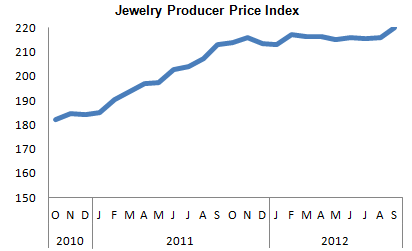 Source: BLS |
RETAIL: Jewelry & Watch Prices Rise in September
In September, the Jewelry & Watch Consumer Price Index (JCPI) stood at 171.3 versus August’s 168.7. A year ago, the JCPI stood at 166.7. For the first eight months of the year, the retail jewelry and watch price index was relatively stable in the 167-168 range, though it had shown some volatility, dipping to 164 in May and July. Here’s what the sharp increase in the index during September means:
· Retail prices of fine jewelry and watches rose by 1.5 percent on a month-to-month comparison basis: September versus August 2012. This implies an annual inflation rate of nearly 18 percent, an unrealistic level.
· Retail jewelry and watch prices in September were 2.8 percent above prices in September 2011. Retail prices of jewelry and watches had shown no significant inflation since mid-2011, but in both August and September, there is solid evidence that retail jewelry and watch prices are headed higher.
· The sharp month-to-month retail price increases in August and September have finally pushed jewelry and watch prices back above the former peak levels at the beginning of 2012. Retailers are beginning to make up for the deflationary retail price trends which occurred between January and July 2012. However, retail jewelers’ margins remain squeezed.
· Retail jewelry and watch prices were up by a moderate 2.1 percent for the nine months year-to-date 2012 versus the same period a year ago.
· The graph below summarizes the JCPI over the past two years:
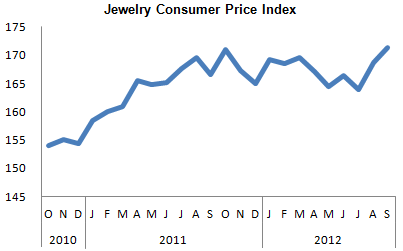 Source: BLS |
After trending lower for the first three quarters of 2012, precious metal prices have begun to rise. For the first eight months through August, prices remained relatively stable. But September’s inflation levels – driven by investor interest in gold and other precious metal assets – drove jewelry prices higher. Clearly, it did not take long for jewelry suppliers and retailers to react to higher costs.
The table below provides detailed inflation / deflation rates for jewelry components as well as inflation rates at various levels of the jewelry distribution channel in the U.S. jewelry industry. The following data is shown: 1) year-to-year price comparisons for the month of September 2012 versus September 2011; 2) month-to-month price comparisons for September 2012 versus August 2012; and 3) nine months year-to-date 2012 price comparisons versus the same nine-month year-to-date period in 2011.
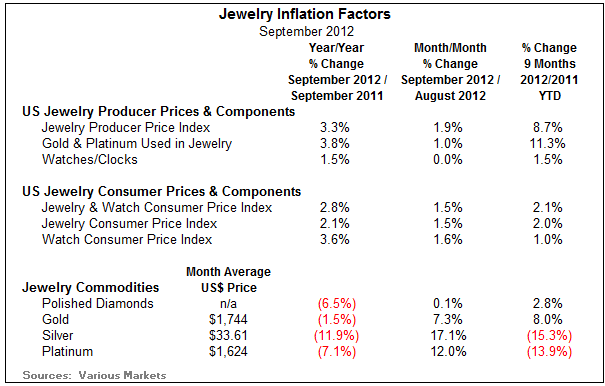 |
Jewelry Suppliers’ Price Inflation Still Running Below 2011 Rate
September’s jewelry supplier price inflation rate of 3.3 percent, year-to-year, was significantly less than 2011’s inflation rate of 13.9 percent, and it was well below the jewelry supplier inflation rate of 9.3 percent for the full year 2010. However, it may turn out to be the inflection point for higher inflation longer term.
After nine months of 2012, jewelry supplier price inflation is up by 8.7 percent, a rate which has been slowing all year, dragged down by deflation earlier this year.
The graph below summarizes year-over-year jewelry supplier price inflation.
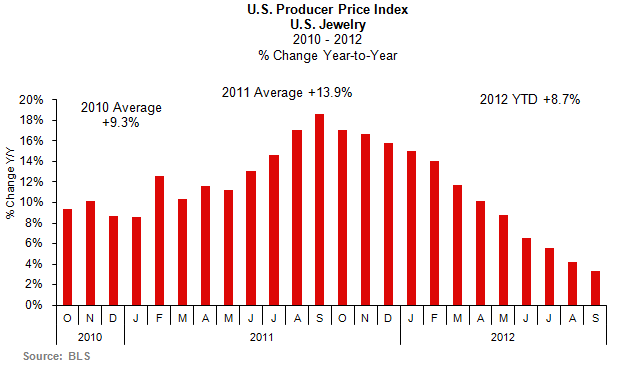 |
Precious Metals Prices Up, But Gemstone Prices Remain Flattish
Jewelry suppliers’ prices of precious metals jewelry rose by only about 4 percent during September 2012 versus the same month a year ago. After nine months, precious metals price inflation is up by over 11 percent.
On a month-over-month basis, jewelry suppliers’ prices for precious metal jewelry were up by a robust 1 percent in September versus August 2012. On an annualized basis, this would suggest that suppliers’ jewelry prices could increase by 12 percent or so. Last month (August 2012), month-to-month prices indicated a 2 percent annual inflation rate, a swing from July’s deflation rate of nearly 2 percent. These unrealistic monthly swings illustrate why IDEX Online Research does not put much emphasis on monthly price changes: they simply are not meaningful.
The graph below compares the jewelry supplier inflation rate for precious metals jewelry (gold columns) versus the overall jewelry supplier inflation rate for jewelry (red columns). These comparisons are year-to-year.
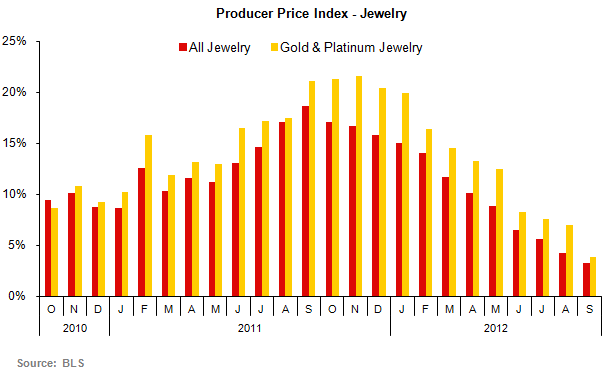 |
Supplier Watch Price Inflation Steady for Past Year
Fine watch prices at the supplier level in September showed a moderate gain – +1.5 percent – when compared to the same month a year ago (September 2011). This level of inflation is reminiscent of inflation trends in 2009 and early 2010, when watch prices rose by a low single-digit level at the supplier level. After nine months of 2012, watch prices are up a modest 1.5 percent year-to-date.
On a month-to-month basis – September 2012 versus August 2012 – supplier prices of watches were flat, showing neither deflation nor inflation. .
In recent months, watch demand and watch sales in the U.S. market have been relatively solid. However, some watch manufacturers have been reticent to raise prices because management worries that it could hurt consumer demand.
The graph below shows year-to-year supplier price inflation for watches for the past twenty-four months.
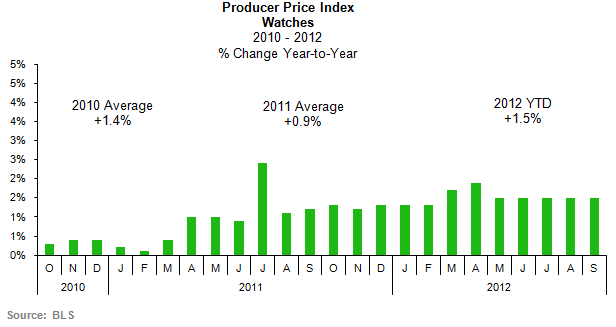 |
Retail: Fine Jewelry and Watch Prices Rise in September
Jewelry and watch retail price inflation had been moderating since the third quarter of 2011 on a year-over-year comparison. But that does not tell the full story in August. After drifting lower for most of 2012, retail prices of jewelry showed a sharp increase in August, when compared to July. September price inflation showed another sharp increase.
Year-over-year prices were up by 2.8 percent at the retail level. While muted consumer demand for jewelry, along with moderating price inflation for jewelry commodity materials, had kept a lid on retail jewelry prices earlier this year, it appears that higher precious metals prices have translated quickly to higher retail jewelry prices.
On a month-to-month basis, retail jewelry and watch prices in September were up 1.5 percent, when comparing September 2012 to August 2012. Comparing the first nine months of 2012 versus the same nine-month period last year, retail jewelry prices are up by 2.1 percent; this implies an annualized inflation rate of 3 percent or so.
The graph below summarizes year-to-year retail jewelry and watch price inflation in the U.S. market. It is clear that retail price inflation had slowed significantly, but picked up in September.
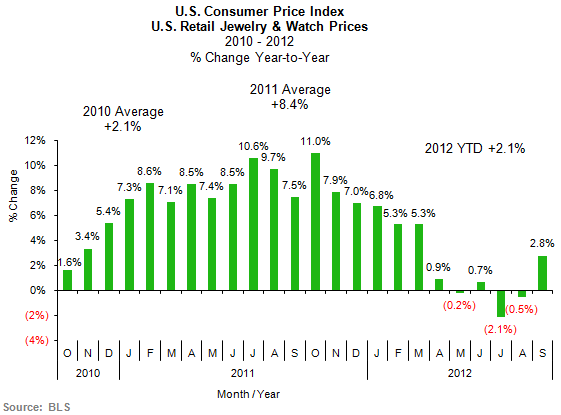 |
Retail Watch Prices vs. Retail Jewelry Prices: Both Rise in September
Retail and supplier prices of watches historically have tended to move together, both on a month-to-month basis and a year-to-year basis, over the past few years. This trend occurred in September.
Retail Fine Watch Prices Up
For the month of September 2012, retail watch prices rose by a strong 3.6 percent from September 2011. This is much higher than recent monthly comparisons of year-over year prices.
Watch prices rose by 1.6 percent, when comparing September to August 2012 prices.
Retail Fine Jewelry Prices Move Higher
Retail prices of jewelry, excluding watches, were up 2.1 percent in September 2012, when compared to September 2011 prices. This is a dramatic change from the past five months, when fine jewelry prices were volatile – marginally up, or down significantly.
The graph below compares the inflation rate for jewelry and watches (green bars), jewelry only (red bars), and watches (gold bars).
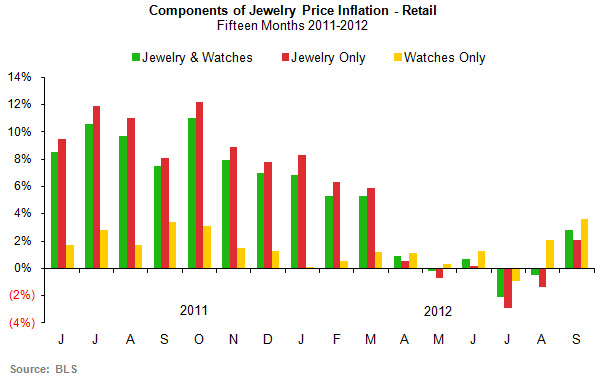 |
Jewelry Inflation Outlook Unchanged: Moderate Inflation in 2012
Our outlook for jewelry price inflation remains unchanged: jewelry prices are expected to move modestly higher at all levels of the distribution channel throughout 2012. But, the rate of inflation is expected to be well below 2011’s torrid pace, both at the supplier level and at the retail level.